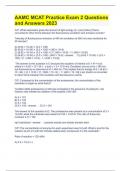Aamc material - Study guides, Class notes & Summaries
Looking for the best study guides, study notes and summaries about Aamc material? On this page you'll find 34 study documents about Aamc material.
Page 3 out of 34 results
Sort by
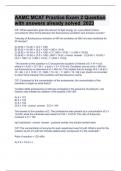
-
AAMC MCAT Practice Exam 2 Question with answers already solved 2023
- Exam (elaborations) • 55 pages • 2023
-
Available in package deal
-
- $16.49
- + learn more
AAMC MCAT Practice Exam 2 Question with answers already solved 2023C/P: What expression gives the amount of light energy (in J per photon) that is converted to other forms between the fluorescence excitation and emission events? "intensity of fluorescence emission at 440 nm excitation at 360 nm) was monitored for 20 minutes" A) (6.62 × 10-34) × (3.0 × 108) B) (6.62 × 10-34) × (3.0 × 108) × (360 × 10-9) C) (6.62 × 10-34) × (3.0 × 108) × [1 / (360 × 10-9) - 1 / (440 × 10-9...
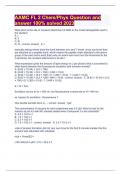
-
AAMC FL 2 Chem/Phys Question and answer 100% solved 2023
- Exam (elaborations) • 14 pages • 2023
-
Available in package deal
-
- $16.49
- + learn more
AAMC FL 2 Chem/Phys Question and answer 100% solved 2023What atom is the site of covalent attachment of AMC to the model tetrapeptide used in the studies? A. I B. II C. III D. IV A. I basically asking where does the bond between amc and Y break. since you know they are attached by a peptide bond, which means the peptide chain attaches to the amino group of the next amino acid( that's why an amino acid runs from the N-terminal to the C-terminal), the covalent attachment is at site 1 ...
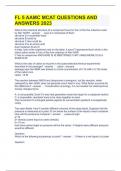
-
FL 5 AAMC MCAT QUESTIONS AND ANSWERS 2023
- Exam (elaborations) • 14 pages • 2023
-
Available in package deal
-
- $16.99
- + learn more
FL 5 AAMC MCAT QUESTIONS AND ANSWERS 2023 What is the chemical structure of a component found in four of the five cofactors used by Na+-NQR? says it is composed of flavin structure is a nucleotide base structure B could be structure C also could be structure D is an amino acid down between B and C to help, look at the captioned note on the table. it says Fl represents flavin which is the redox active center in four of the five cofactors of Na+-NQR C has an uniquinone AND HERE IS IS MENT...
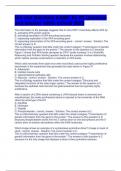
-
Bio and Biochem AAMC FL #2 Question and answer 100% solved 2023
- Exam (elaborations) • 18 pages • 2023
-
Available in package deal
-
- $15.49
- + learn more
Bio and Biochem AAMC FL #2 Question and answer 100% solved 2023The information in the passage suggests that in mice CRY1 most likely affects XPA by: A. activating XPA protein activity. B. activating translation of XPA-encoding transcripts. C. repressing replication of the XPA-encoding gene. D. repressing transcription of the XPA-encoding gene. Solution: The correct answer is D. This is a Biology question that falls under the content category “Transmission of genetic information from th...
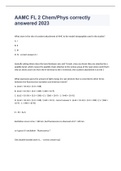
-
AAMC FL 2 Chem/Phys correctly answered 2023
- Exam (elaborations) • 20 pages • 2023
- Available in package deal
-
- $14.99
- + learn more
AAMC FL 2 Chem/Phys correctly answered 2023What atom is the site of covalent attachment of AMC to the model tetrapeptide used in the studies? A. I B. II C. III D. IV - correct answer A. I basically asking where does the bond between amc and Y break. since you know they are attached by a peptide bond, which means the peptide chain attaches to the amino group of the next amino acid( that's why an amino acid runs from the N-terminal to the C-terminal), the covalent attachment is at site 1 ...
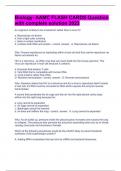
-
Biology- AAMC FLASH CARDS Question with complete solution 2023
- Exam (elaborations) • 7 pages • 2023
-
Available in package deal
-
- $12.49
- + learn more
Biology- AAMC FLASH CARDS Question with complete solution 2023An organism is likely to be a bacterium rather than a virus if it a. Reproduces via fission b. Has a rigid outer covering c. lacks a nuclear membrane d. contains both RNA and protein A. Reproduces via fission Why: Viruses reproduces by replicating within a host cell and thus cannot reproduce via fission as bacteria do. HIV is a retrovirus , an RNA virus that can insert itself into the human genome. This virus can re...
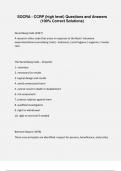
-
SOCRA - CCRP (high level) Questions and Answers (100% Correct Solutions)
- Exam (elaborations) • 68 pages • 2023
-
Available in package deal
-
- $10.49
- + learn more
Nuremberg Code (1947) A research ethics code that arose in response to the Nazis' inhumane experimentation (nuremberg trials) - holocaust, racial hygiene / eugenics / master race. The Nuremberg Code - 10 points 1. voluntary 2. necessary for results 3. logical design and results 4. avoid unnecessary harm 5. cannot result in death or disablement 6. risk assessment 7. protect subjects against harm 8. qualified investigators 9. right to withdrawal 10. right to end trial if needed ...
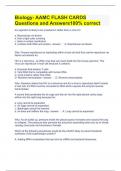
-
Biology- AAMC FLASH CARDS Questions and Answers100% correct
- Exam (elaborations) • 7 pages • 2023
-
Available in package deal
-
- $16.49
- + learn more
Biology- AAMC FLASH CARDS Questions and Answers100% correct An organism is likely to be a bacterium rather than a virus if it a. Reproduces via fission b. Has a rigid outer covering c. lacks a nuclear membrane d. contains both RNA and protein A. Reproduces via fission Why: Viruses reproduces by replicating within a host cell and thus cannot reproduce via fission as bacteria do. HIV is a retrovirus , an RNA virus that can insert itself into the human genome. This virus can rep...
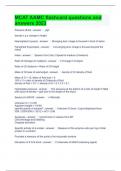
-
MCAT AAMC flashcard questions and answers 2023
- Exam (elaborations) • 5 pages • 2023
-
Available in package deal
-
- $10.99
- + learn more
MCAT AAMC flashcard questions and answers 2023 Pressure (fluid) pgh density x g x change in height Nearsighted (myopic) Diverging lens; image is focused in front of retina Farsighted (hyperopia) Converging lens; image is focused beyond the retina Index Speed of air (Vair) / Speed of medium (Vmedium) Ratio of h(image) to h(object) f of image/ f of object Ratio of O/I distance = Ratio of O/I height Mass of O/mass of submerged density of O/ density of...

How did he do that? By selling his study resources on Stuvia. Try it yourself! Discover all about earning on Stuvia

